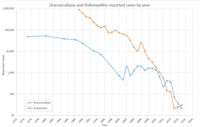Alastrim
| Alastrim | |
|---|---|
| Classification and external resources | |
| Specialty | infectious disease |
| ICD-10 | B03 |
| ICD-9-CM | 050.1 |
| MeSH | D012899 |
Alastrim, also known as variola minor, was the milder strain of the variola virus that caused smallpox. The last known case of variola minor was in Somalia, Africa in 1977. Smallpox was formally declared eradicated in May 1980.[1]
Variola minor is of the genus orthopoxvirus, which are DNA viruses that replicate in the cytoplasm of the affected cell, rather than in its nucleus. Like variola major, alastrim was spread through inhalation of the virus in the air, which could occur through face-to-face contact or through fomites. Infection with variola minor conferred immunity against the more dangerous variola major.
Variola minor was a less common form of the virus, and much less deadly. Although alastrim had the same incubation period and pathogenetic stages as smallpox, alastrim is believed to have had a mortality rate of less than 1%, as compared to smallpox's 30%.
Because alastrim was a less debilitating disease than smallpox, patients were more frequently ambulant and thus able to infect others more rapidly. As such, variola minor swept through the USA, Great Britain, and South Africa in the early 20th century, becoming the dominant form of the disease in those areas and thus rapidly decreasing mortality rates.
Alastrim was also called white pox, kaffir pox, Cuban itch, West Indian pox, milk pox, and pseudovariola.
Like smallpox, alastrim has now been totally eradicated from the globe thanks to the 1960s Global Smallpox Eradication campaign. The last case of indigenous variola minor was reported in a Somali cook, Ali Maow Maalin, in October 1977, and smallpox was officially declared eradicated worldwide in May 1980.
